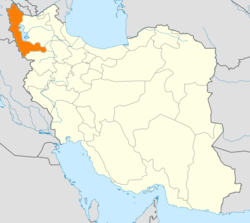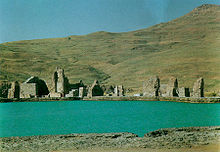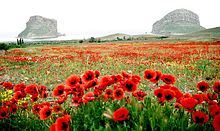- West Azerbaijan Province
-
This article is about the Iranian province. For other places named Azerbaijan, see Azerbaijan (disambiguation).
West Azerbaijan Province
استان آذربایجان غربی— Province — Location of West Azerbaijan within Iran Coordinates: 37°33′10″N 45°04′33″E / 37.5528°N 45.0759°ECoordinates: 37°33′10″N 45°04′33″E / 37.5528°N 45.0759°E Country  Iran
IranCapital Urmia Counties 17 Area – Total 37,437 km2 (14,454.5 sq mi) Population (2005) – Total 2,949,426 – Density 78.8/km2 (204/sq mi) Time zone IRST (UTC+03:30) – Summer (DST) IRST (UTC+04:30) Main language(s) Persian (official)
local languages:
Kurdish[1]
Azerbaijani[2]
Armenian
Assyrian
.West Azerbaijan Province or West Azarbaijan Province (Persian: استان آذربایجان غربی, Ostān-e Āzarbāijān-e Gharbī ), is one of the 31 provinces of Iran. It is located in the North West of the country, bordering Turkey, Iraq and Nakhchivan, and the provinces of East Azerbaijan, Zanjan and Kurdistan.
The province of West Azerbaijan covers an area of 39,487 km², or 43,660 km² including Lake Urmia. In 2006 the province had a population of 3,015,361 [2]. The capital city and largest city of the province is Urmia.
Contents
History
The region was once part of the Neo Assyrian Empire. The name of Azerbaijan derives from Atropates,[3][4] an Iranian satrap of Media under the Achaemenid empire, who later was reinstated as the satrap of Media under Alexander of Macedonia.[5] The original etymology of this name is thought to have its roots in the ancient Zoroastrianism, namely, in Avestan Frawardin Yasht ("Hymn to the Guardian Angels"), there is a mentioning of: âterepâtahe ashaonô fravashîm ýazamaide, which literally translates from Old Persian as "we worship the Fravashi of the holy Atare-pata".[6] Atropates ruled over the region of present-day Iranian Azerbaijan.
According to various sources cited in Encyclopædia Iranica,[7] the current province of West Azerbaijan was part of the Sassanid Azarbadegan satrap as far back as the 3rd century.[8] The current ruins of Takht-i Suleiman in today's West Azerbaijan was the capital of the Azerbaijan Satrapy.[9]
Permanent settlements were established in the province as early as the 6th millennium BC as excavation at sites such as Teppe Hasanlu establish. In Hasanlu, a famous Golden Vase was found in 1958. The province is also the location of Tepe Hajji Firuz, site of some of the world's earliest evidence of wine production.[10][11] Gooy Teppe is another significant site, where a metal plaque dating from 800 BC was found that depicts a scene from the epic of Gilgamesh.
Ruins such as these and the UNESCO world heritage site at the Sassanid compound of Takht-i-Suleiman illustrate the strategic importance and tumultuous history of the province through the millennia. Overall, the province enjoys a wealth of historical attractions, with 169 sites registered by the Cultural Heritage Organization of Iran.
While some Muslim researchers[12] have proclaimed that the birth of the prophet Zoroaster was in this area, in the vicinity of Lake Orumieh (Chichesht), Konzak City, recent scholarship indicates that Ardabil or sites in Central Asia are more likely.[13]
The province continued to experience many wars over the centuries. Numerous Azeris arrived in the region, including to the west of Lake Urmia beginning around the 13th century.[7]
The first monarch of Iran's Qajar dynasty, Mohammad Khan Qajar, was crowned in Urmia in 1795.
Significant events in 19th and 20th century that took place are:
- Shaikh Ubeidullah Revolts, west and south of Lake Urmia in 1880;[14]
- Simko Insurrections, west of Lake Urmia from 1918 to 1922;[15]
- the Soviet occupation in 1946;
- the foundation and destruction of the Republic of Mahabad in 1946; and
- periodic severe fighting from 1979 until 1990s (and even to the present, but on a smaller scale [3]) between Kurdish (nationalist and communist) forces and the Iranian government. At times, large parts of the province were without government control [4].
These separatist movements may have many motivations and origins; however, the colonialist policies of the Soviet Union and Imperial Russia encouraged such movements. In a cable sent on July 6, 1945 by the Central Committee of the Communist Party of the Soviet Union, the local Soviet commander in Russian held Azerbaijan (northern Azerbaijan) was instructed:
- "Begin preparatory work to form a national autonomous Azerbaijan district with broad powers within the Iranian state and simultaneously develop separatist movements in the provinces of Gilan, Mazandaran, Gorgan, and Khorasan".[16]
Geography and climate
With an area of 43,660 square kilometers, including Lake Urmia, the province of West Azerbaijan is located on the north-west of Iran.
The climate of the province is largely influenced by the rainy winds of the Atlantic Ocean and Mediterranean. Cold northern winds affect the province during winter and cause heavy snow. According to existing meteorological data, local temperatures vary within the province. Average temperature differs from 9.4 °C in Piranshahr to 11.6 °C in Mahabad, while it is 9.8 °C in Urmia, 10.8 °C in Khoy, 9.4 °C in Piranshahr, and in Mahabad 11.6 °C. According to same data, the highest temperature in the province reaches 34 °C in July, and the lowest temperature is –16 °C in January. Maximum change of temperature in summer is 4 °C, and in winter 15 °C. West Azerbayjan province, encompassing vast and fertile plains, high mountains, enjoying moderate and healthy weather, rivers with high volume of water, vineyards, orchards, luxuriant forest and rangelands, mountain outskirt with wonderful flora, magnificent wildlife and beautiful shores around the lake with different recreational facilities, which all together form one of the most beautiful and spectacular region in Iran. A land with wonderful flora during the spring and the summer covered with tulip, poppy, narcissus and hyacinth extending from Arass rivers banks in the north to Zab Kouchak valley in the south.
Administrative divisions
West Azerbaijan counties The province is divided into 14 shahrestans (counties). The present number of shahrestans (counties) was achieved over time by subdivision of many of the larger shahrestans into smaller ones. The current shahrestans are: Piranshahr, Urmia, Mahabad, Oshnaviyeh, Miandoab, Naghadeh, Takab, Shahindej, Maku, Chaldoran County, Salmas, Khoy, Sardasht and Bukan.
Demographics
There are no official statistics or census figures on the ethnic makeup of Iran. The bulk of the population in West Azerbaijan Province are mainly Azerbaijanis[17] and Kurds.[18] There are three ethnic and religious groups who are native to the province but who have minority status: Assyrians, Armenians, and Jews. There are also immigrants from other parts of Iran in the major cities of the province.
The diversity of religions in the province has been a major factor throughout the entire history of the province. The religions in the province are: Shia and Sunni Islam, Christianity, Judaism, and Yarasani. Both Azeris and Kurds follow Islam, the Kurds belonging mainly to the Sunni branch and the Azerbaijanis being Shias. There is also a very small minority who follow a religion called Yarasani (or Ahl-e Haqq, اهل حق). Christianity is the only religion of the Assyrians, and Armenians. The Jews, as the name indicates, belong to the Jewish religion.There are also Bahais and Zoroastrians in the province.
Religion
In this province, Islam (Sunni and Shiite) is the majority religion. However, there is also a large Assyrians Christian minority, who have historically lived on the west shore of Lake Urmia, as well as Armenians who are scattered throughout the province. Notably, the city of Maku in northern West Azerbaijan was the only city in Iran (before World War II) where Christians comprised the majority.
St. Thaddeus Cathedral is located on the outskirts of Chaldoran, near the village of Qara-Kelissa. Besides being a religious site with a particular significance among Christians, particularly Armenians, this large church (monastery) is also a rare and valuable monument in architectural and artistic terms.
St. Thaddeus, also known as Jude Thaddeus or Jude Labbeus, was one of the apostles of Jesus Christ who traveled to Armenia, where he was later killed and upon whose grave the locals erected a small chapel in AD 301. The cathedral is known as Qara-kelissa ('Black church' in Turkish) to the locals, owing to the appearance of its western section. In 1329, the church was reconstructed in its present form after an earthquake destroyed the structure in 1319.
The Armenian Monastic Ensembles in Iran * UNESCO World Heritage Site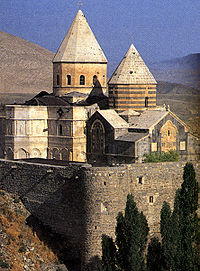
Saint Thaddeus Monastery (Qara Kelissa), Chaldoran. Believed by some to have been first built in AD 66 by Saint Jude. Local Armenians believe that he and Simon were both buried here.Country  Iran (Islamic Republic of)
Iran (Islamic Republic of)Type Cultural Criteria ii, iii, vi Reference 1262 Region ** Asia-Pacific Inscription history Inscription 2008 (32nd Session) * Name as inscribed on World Heritage List
** Region as classified by UNESCOChurches in West Azerbaijan
In all, thirty-one churches are registered by the Cultural Heritage Organization of Iran in the province. Many of these are historical landmarks and unusually rich in heritage. Some of the more famous ones are listed as follows:[19]
Armenian Churches
- Monastery of St. Thaddeus (Surp Tade Vank) - Maku - Karakelisa - Early Christianity (Renovated in 1329 and 1820)
- St. Sandukht (Surp Sandukht) Church - Maku - Karakelisa - 14th c.
- St. Vardan (Surp Vardan) Church - Maku - Shaveran - 18th c.
- Monastery of Holy Mary (Surp Asdvadzadzin Vank) - Maku - Baron (Dzor Dzor) - 1324
- St. Sarkis (Surp Sarkis) Church - Khoy - 1120
- Holy Cross of Christ (Surp Khatch Kristosi) Church - Khoy - Mahlazan - 1656
- Holy Mary (Surp Asdvadzadzin) Church - Khoy - Ghris - 16th c.
- St. Sarkis (Surp Sarkis) Church - Khoy - Fanai - 16th c.
- Holy Mary (Surp Asdvadzadzin) Church - Khoy - Dizeh - 18th c.
- St. Sarkis the Commander (Surp Sarkis Zoravar) Church - Khoy - Var - 18th c.
- St. James (Surp Hakop) Church - Khoy - Saeedabad - 18th c.
- Holy Mary (Surp Asdvadzadzin) Church - Salmas - Akhtekhaneh - 18th c.
- St. James (Surp Hakop) Church - Salmas - Aslanik - 1886
- St. George (Surp Gevorg) Church - Salmas - Charik - 1203
- St. Sarkis the Commander (Surp Sarkis Zoravar) Church - Salmas - Drishk - 1400
- St. Sarkis (Surp Sarkis) Church - Salmas - Qalasar - 1806
- Sts. Paul-Peter (Surp Poghos-Petros) Church - Salmas - Qezeljeh
- St. John (Surp Hovhannes) Church - Salmas - Qezeljeh - 1189
- Holy Mary (Surp Asdvadzadzin) Church - Salmas - Haftvan - 18th c.
- St. George (Surp Gevorg) Church - Salmas - Haftvan - 1652
- St. Thaddeus (Surp Tadevos) Church - Salmas - Haftvan - 13th c.
- Sts. Paul-Peter (Surp Poghos-Petros) Church - Salmas - Haftvan
- St. Sarkis (Surp Sarkis) Church - Salmas - Khosrowabad - 1717
- St. Sarkis (Surp Sarkis) Church - Salmas - Goluzan - 18th c.
- Holy Mary (Surp Asdvadzadzin) Church - Salmas - Sheitanabad - 1708
- St. George (Surp Gevorg) Church - Salmas - Payajuk - 1751
- St. George (Surp Gevorg) Church - Salmas - Karabulagh
- St. George (Surp Gevorg) Church - Salmas - Hodar - 1813
- St. James (Surp Hakop) Church - Salmas - Kohneshahr - 1671
- St. Sarkis (Surp Sarkis) Church - Salmas - Kohneshahr - 1671
- St. John (Surp Hovhannes) Church - Salmas - Kohneshahr - 1825
- St. Sarkis the Commander (Surp Sarkis Zoravar) Church - Salmas - Malham - 1711
- St. Vardan (Surp Vardan) Church - Salmas - Malham - 1724
- Holy Monks (Surp Chknavorats) Church - Salmas - Malham - 1796
- St. Sarkis (Surp Sarkis) Church - Salmas - Saramolk - 1758
- Holy Mary (Surp Asdvadzadzin) Church - Salmas - Sarna - 1625
- St. George (Surp Gevorg) Church - Salmas - Savera - 18th c.
- All Saviour (Surp Amenaprgitch) Church - Salmas - Zivajik - 1892
- St. Sarkis (Surp Sarkis) Church - Salmas - Kojamish - 1348
- St. Sarkis (Surp Sarkis) Church - Salmas - Ula
- St. Stephen (Surp Stepanos) Church - Urmia - 18th c.
- St. John (Surp Hovhannes) Church - Urmia - Balanej - 17th c.
- St. John (Surp Hovhannes) Church - Urmia - Badelbo - 18th c.
- St. Sarkis (Surp Sarkis) Church - Urmia - Surmanabad - 18th c.
- Holy Sign (Surp Nshan) Church - Urmia - Jamalabad - 18th c.
- St. John (Surp Hovhannes) Church - Urmia - Jamalabad - 18th c.
- St. George (Surp Gevorg) Church - Urmia - Gardabad - 17th c.
- St. Sarkis (Surp Sarkis) Church - Urmia - Ikiaghaj - 17th c.
- Holy Mary (Surp Asdvadzadzin) Church - Urmia - Isalu - 17th c.
- Holy Mary (Surp Asdvadzadzin) Church - Urmia - Karaguz - 18th c.
- St. John (Surp Hovhannes) Church - Urmia - Karagiz - 18th c.
- Holy Mary (Surp Asdvadzadzin) Church - Urmia - Nakhichevan Tepe - 17th c.
- Holy Mary (Surp Asdvadzadzin) Church - Urmia - Reihanabad - 17th c.
- Holy Mary (Surp Asdvadzadzin) Church - Urmia - Sepurghan - 17th c.
- St. Sarkis (Surp Sarkis) Church - Urmia - Sepurghan - 17th c.
- St. Peter (Surp Petros) Church - Urmia - Karabagh - 1655
- St. John (Surp Hovhannes) Church - Urmia - Adeh - 17th c.
- Holy Mary (Surp Asdvadzadzin) Church - Urmia - Dizej Ala - 1820
- St. John (Surp Hovhannes) Church - Urmia - Khan Babakhan - 17th c.
- St. Sarkis (Surp Sarkis) Church - Urmia - Kachilan - 17th c.
- St. George (Surp Gevorg) Church - Urmia - Shirabad - 18th c.
- Holy Mary (Surp Asdvadzadzin) Church - Urmia - Charbakhsh - 1882
- Sts. Paul-Peter (Surp Poghos-Petros) Church - Urmia - ChaharGushan - 18th c.
- Holy Mary (Surp Asdvadzadzin) Church - Urmia - Rahava - 17th c.
- Holy Mary (Surp Asdvadzadzin) Church - Urmia - Ballu - 17th c.
- St. Sarkis (Surp Sarkis) Church - Urmia - Darbarud - 18th c.
- St. Sarkis (Surp Sarkis) Church - Urmia - Kukia - 18th c.
- Holy Mary (Surp Asdvadzadzin) Church - Urmia - Babarud - 18th c.
- St. Sarkis (Surp Sarkis) Church - Miandoab - Taqiabad
Assyrian Churches
- Holy Mary (Mart Maryam) Church - Urmia - 1st c.
- St. Cyriacus (Mar Kuryakus) Church - Urmia - 18th c.
- Holy Mary (Mart Maryam) Church - Urmia - CharBakhsh - 5th c.
- Holy Gabriel (Mar Gabriel) Church - Urmia - Ordushahi - 19th c.
- St. Shalita (Mar Shalita) Church - Urmia - Shirabad - 19th c.
- St. Joseph (Mar Yozef) Church - Urmia - Shirabad - 1897
- St. Sarkis (Mar Sargiz) Church - 5 km SW of Urmia - Seir - 5th c.
- Holy Zion (Mar Sehyon) Church - 8 km E of Urmia - Golpashan
- St. George (Mar Gevargiz) Church - 8 km E of Urmia - Golpashan - 1905
- Holy Mary (Mart Maryam) Church - 8 km E of Urmia - Golpashan
- Sts. Peter-Paul (Mar Petros-Paulos) Church - 10 km E of Urmia - 8th c. - believed to be built by Bukhtishu
- Holy Mary (Mart Maryam) Church - 32 km E of Urmia - Mavana
- St. Daniel (Mar Danial) Church - 25 km N of Urmia - Nazlu River - 5th c. - destroyed in World War I, rebuilt
- St. John (Mar Yokhnah) Church - 45 km N of Urmia - Jamalabad - 5th c.
- St. John (Mar Yokhnah) Church - 24 km N of Urmia - Adeh - 1901
- St. Sabrisho (Mar Sabrisho) Church - 30 km N of Urmia - Mushiabad - 1880
- St. George (Mar Gevargiz) Church - 35 km N of Urmia - Sepurghan - 1830
- St. John (Mar Yokhnah) Church - 40 km N of Urmia - Gavilan - 5th c.
- St. John (Mar Yokhnah) Church - 40 km N of Urmia - Gavilan - 19th c.
- St. Thomas (Mar Toma) Church - 30 km W of Urmia - Balulan - 7th c.
- St. Cyriacus (Mar Kuryakus) Church - Salmas - Kohneshahr - 12th c.
- St. James (Mar Yakob) Church - Salmas - Kohneshahr - 19th c.
- St. Khinah (Mar Khinah) Church - Salmas - Sarna
- Holy Mary (Mart Maryam) Church - Salmas - Savera
- Vank - 2 km S of Salmas - Khosrowabad - 5th c. - The Holy Cross of Jerusalem was kept here for a while.
- St. Sarkis (Mar Sargiz) Church - 2 km S of Salmas - Khosrowabad - 1869
- St. George (Mar Gevargiz) Church - 2 km S of Salmas - Khosrowabad - 1845
- Church - 12 km SW of Salmas - Akhtekhaneh - 1890
- St. Sarkis (Mar Sargiz) Church - 2 km S of Salmas - Khosrowabad - 1869
In 2008, UNESCO selected a group of these religious structures as part of the Armenian Monastic Ensembles in Iran World Heritage Site.[20]
West Azerbaijan today
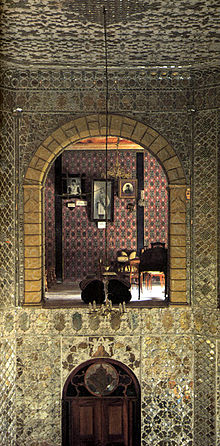 Kakh Muzeh Maku, near Maku, built by one of the commanders of Mozzafar-al-Din Shah, is a popular attraction.
Kakh Muzeh Maku, near Maku, built by one of the commanders of Mozzafar-al-Din Shah, is a popular attraction.
The city of Urmia has a higher standard of living in comparison with the other cities of the province. There are plenty of parks, coffee shops, cinemas, and internet cafes throughout the city. There are hundreds of small villages in the province as well, most of which have running water and electricity as well as television, satellite, and telephone lines. Southern cities which economically are considered poor areas have always been the venue of Kurdish demonstrators against the Islamic regime. [5]
West Azerbaijan Province is one of the most important provinces for Iran's agriculture.
Iran's current Minister of Energy, Parviz Fattah is from Urmia.
Culture
West Azerbaijan possesses a rich culture, stemming from Azeri and Kurdish traditions. Many local traditions, such as music and dance, continue to survive among the various peoples of the province. As a longstanding province of Persia, West Azerbaijan is mentioned favorably on many occasions in Persian literature by Iran's greatest authors and poets:
گزیده هر چه در ایران بزرگان
زآذربایگان و ری و گرگانAll the nobles and greats of Iran,
Choose from Azarbaijan, Ray, and Gorgan.
--Vis o Raminاز آنجا بتدبیر آزادگان
بیامد سوی آذرآبادگانFrom there the wise and the free,
set off to Azarbaijan
--Nizamiبیک ماه در آذرآبادگان
ببودند شاهان و آزادگانFor a month's time, The Kings and The Free,
Would choose in Azarbaijan to be
--FirdowsiColleges and universities
Urmia University was first built by an American Presbyterian missionary in 1878. A medical faculty was also established there headed by Joseph Cochran and a team of American medical associates. Joseph Cochran and his colleagues were buried in an old cemetery in the vicinity of Urmia. Urmia University website says this about them:
- There they lie in peace away from their homeland, and the testimonial epitaphs on their tombs signify their endeavor and devotion to humanity.
The province today has the following major institutes of higher education:
- Urmia University [6]
- Urmia University of Medical Sciences
- Urmia University of Technology
- Islamic Azad University of Urmia
- Islamic Azad University of Salmas
- Islamic Azad University of Khoi
- Islamic Azad University of Piranshahr
- Payame Noor University of Piranshahr
- Islamic Azad University of Mahabad
References
- ^ Keith Stanley McLachlan, "The Boundaries of Modern Iran ", Published by UCL Press, 1994. pg 55
- ^ http://countrystudies.us/iran/41.htm
- ^ Minorsky, V.; Minorsky, V. Ādharbaydjān ( Azarbāydjān ) . Encyclopaedia of Islam. Edited by: P.Bearman, Th. Bianquis, C.E. Bosworth, E. van Donzel and W.P. Heinrichs. Brill, 2007. Brill Online. [1]
- ^ Encyclopædia Iranica, "Azerbaijan: Pre-Islamic History", K. Shippmann
- ^ Historical Dictionary of Azerbaijan by Tadeusz Swietochowski and Brian C. Collins. The Scarecrow Press, Inc., Lanham, Maryland (1999), ISBN 0-8108-3550-9 (retrieved 7 June 2006)
- ^ Frawardin Yasht ("Hymn to the Guardian Angels") -- translated by James Darmesteter (From Sacred Books of the East, American Edition, 1898)
- ^ a b Encyclopædia Iranica, p.206
- ^ ibid p.206
- ^ ibid p.206
- ^ "World's Oldest Known Wine Jar" University of Pennsylvania Museum of Archaeology and Anthropology
- ^ Voigt, Mary M. and Meadow, Richard H. (1983) Hajji Firuz Tepe, Iran: the neolithic settlement University Museum, University of Pennsylvania, Philadelphia, Pennsylvania, ISBN 0-934718-49-0
- ^ Balādâorī and Ebn Kordādâbeh
- ^ "As a matter of fact, only untrustworthy and late traditions place Zoroaster's birthplace at Urmia." Tarbiyat, Muḥammad Ali (1935) Dānishmandān-i Āzarbayjān Tehran, p. 162, reissued in 1999, ISBN 964-422-138-9
- ^ The Kurdish Question, By W. G. Elphinston, Journal of International Affairs, Royal Institute of International Affairs, 1946, p.94
- ^ The Kurdish Question, By W. G. Elphinston, Journal of International Affairs, Royal Institute of International Affairs, 1946, p.97
- ^ Decree of the CC CPSU Politburo to Mir Bagirov, CC Secretary of the Communist Party of Azerbaijan, on "measures to Organize a Separatist Movement in Southern Azerbaijan and Other Provinces of Northern Iran". Translation provided by The Cold War International History Project at The Woodrow Wilson International Center for Scholars.
- ^ http://countrystudies.us/iran/41.htm
- ^ Keith Stanley McLachlan, "The Boundaries of Modern Iran ", Published by UCL Press, 1994. pg 55
- ^ Azarbaijan Gharbi, Cultural Heritage Organization of Iran publications, ISBN 964-7483-80-5
- ^ Armenian monasteries in Iran added to UNESCO’s World Heritage List (July 6, 2008)
External links
- Piranshahr-ag.ir
- Official website of West Azarbaijan Governor’s Office
- West Azarbaijan’s Government Portal
- Urmia sport news agency
- West Azarbaijan Provincial Management Organization
- West Azarbaijan Cultural Heritage Organization
- Recent photos from Azarbaijan
- Lake Urmia UNESCO Biosphere Reserve
- About Urmia

 Turkey
Turkey Armenia
ArmeniaEast Azerbaijan Province 

 West Azerbaijan Province
West Azerbaijan Province 

 Arbil Governorate
Arbil Governorate
 Sulaymaniyah Governorate
Sulaymaniyah GovernorateKurdistan Province Zanjan Province  West Azerbaijan Province
West Azerbaijan ProvinceCapital 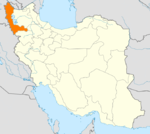
Counties and Cities Siah Cheshmeh · AvajiqQarah Zia od DinPoldasht CountyShahin Dezh CountyShowt CountyVillages List of cities, towns and villages in West Azarbaijan ProvinceSights Shalmash Waterfall · Old bazaar of Khoy · Ghoutour Bridge · Khoshku ski resort · Teppe Hasanlu · Takht-e Soleymān · Farhad's rock grave (Dakhmeh) · Lake Urmia · Bastam Citadel · Zarrineh River dam · Sahulan cave · Fakhrigah cave · Faghrgah · Saint Thaddeus Monastery · Baghchejogh museum and palace · Koleshin Inscription · Nanehmaryam monastery · Baand park · Sir park · Sardar mosque · Urmia museum · Salmas Sassanid relief · SegonbadProvinces of Iran Alborz · Ardabil · Bushehr · Chaharmahal and Bakhtiari · East Azerbaijan · Isfahan · Fars · Gilan · Golestan · Hamadan · Hormozgan · Ilam · Kerman · Kermanshah · Khuzestan · Kohgiluyeh and Boyer-Ahmad · Kurdistan · Lorestan · Markazi · Mazandaran · North Khorasan · Qazvin · Qom · Razavi Khorasan · Semnan · Sistan and Baluchestan · South Khorasan · Tehran · West Azerbaijan · Yazd · Zanjan
Categories:- West Azerbaijan Province
- Provinces of Iran
- Divided regions
- Azerbaijani inhabited regions
- Kurdish inhabited regions
Wikimedia Foundation. 2010.

